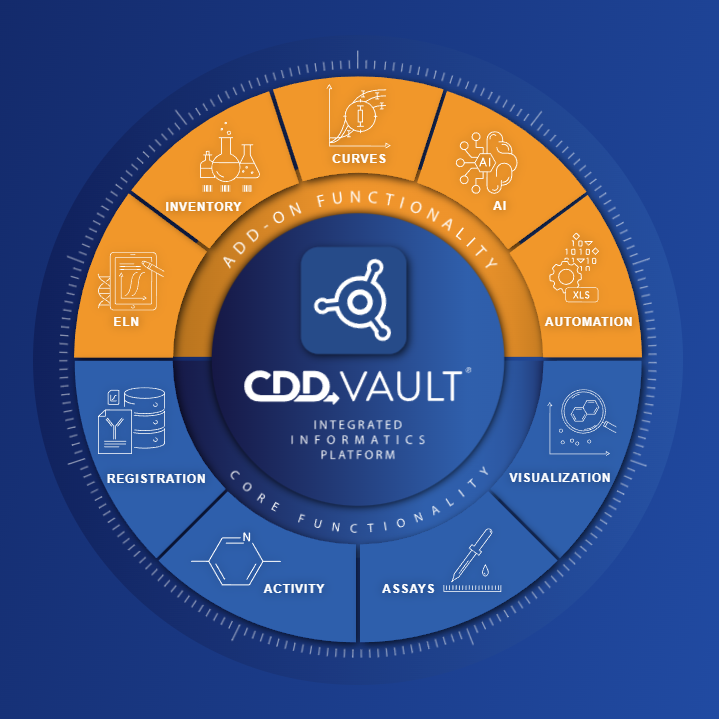Collaborative Drug Discovery Vault: Banking on Shared Data
April 22, 2025
Integrated online data repository powers drug discovery
The days of discovering drugs by chance — an uncovered petri dish by a window, a few spores and a lot of luck — are long gone. Today, scientists systematically test thousands of different molecules, from simple lab-made chemicals to complex substances found in nature. Their goal? To find the few that can actually treat diseases.
This search creates mountains of information about each molecule. In the past, research teams kept this data to themselves, using expensive, customized databases. Sharing information was difficult, leading to wasted time and money and slower progress in finding new treatments.
Barry Bunin, Ph.D., came up with a solution. He started a company called Collaborative Drug Discovery (CDD) in Burlingame, California, and in 2004, created an online tool called CDD Vault. Think of it like a giant online library where scientists all over the world can securely share their research information. By breaking down the walls between research silos, CDD Vault unlocks the collective knowledge and insights needed to bring life-saving therapies to patients faster.
Like CDD Vault, NCATS also aims to speed the delivery of life saving therapies to patients through translational science. The center was very interested in CDD Vault’s approach when Bunin submitted a Small Business Innovation Research (SBIR) proposal in 2013.
“Achieving NCATS’ mission of turning research observations into health solutions through translational science requires programs to identify and address inefficiencies in translation that slow and even stop research efforts,” noted Sury Vepa, Ph.D., J.D., Senior Licensing and Patenting Manager in NCATS’ Office of Strategic Alliances, who served as CDD Vault’s Program Officer. “Funding this project was a true example of a success story for NCATS and CDD Vault.”
Building a bank of research data
“It was clear that modern drug discovery needed to be done as a collaboration between different teams and locations,” said Jason B. Harris, Ph.D., Product Manager and Informatics Life Scientist at CDD. “CDD Vault became that solution, and its success in the hands of thousands of researchers since then is due to its continued innovations around the need to efficiently and effectively work together. Today, CDD Vault hosts over 4 billion bioactivity data measurements from scientists around the world.”
Bunin designed CDD Vault as a secure online platform where researchers worldwide can store, organize and share their data, and that research teams can access through a secure licensed account.
NCATS SBIR funding has helped CDD Vault expand and improve its platform to meet the growing demands in the field of drug discovery. The company has added features to support the management of more complex molecules and assays, as well as more advanced analytical and visualization tools. Researchers can register and track a greater variety of substances, assays and macromolecules, including structural entities like drugs, proteins and antibodies, as well as nonstructural entities like cell lines, mixtures and reagents. They can use the system to manage study protocols, analyze experimental results and track inventory. CDD Vault also incorporates advanced technologies, such as artificial intelligence (AI) for computer-aided design and search, speeding the discovery process. Today, CDD Vault’s AI module, initially developed with NCATS SBIR funding, is the leading tool for generative chemistry (generative bioisosteres).
NCATS support nurtures company growth
“NCATS SBIR funding offered an opportunity to invest in our ideas, build new technologies and partnerships, and recruit excellent talent to the company,” Harris said. With support from NCATS’ SBIR program, CDD has grown tremendously over the past 10 years. The company’s successes include celebrating 5 million customer logins and forging a partnership with the Bill and Melinda Gates Foundation. Case studies featured on its website show that organizations around the world are using CDD Vault to promote research collaboration in the search for drugs to treat everything from viruses to neurodegenerative diseases, as well as track disease outbreaks, streamline workstreams among contract research organizations and improve compliance with research standards.
CDD Vault was awarded a Phase II SBIR grant in 2018 to develop “Cloud Workspaces.” This online tool helps scientists use different computer programs and information sources together. “It enables scientists to effortlessly, robustly and securely integrate different databases and computational tools distributed across multiple systems to implement their drug discovery projects,” Vepa noted.
CDD Vault’s growth allowed them to expand their reach and support more researchers. This includes providing free access to its platform for scientists in underfunded regions and those searching for treatments for neglected diseases.
Harris’ advice to other aspiring SBIR applicants echoes a familiar mantra in drug discovery: “Fail early, fail cheap.”
“If your product solves a clear problem, it’s easier to build a business case and craft a quality proposal for innovation. If there’s no clear value proposition, consider other ideas to best use your time creating applications,” Harris explained. This approach, combined with being open to feedback, has helped CDD expand and refine its products to help drug discovery efforts succeed. The company’s story is a great example of how SBIR funding can catalyze innovation and help small companies bring better solutions to more patients faster.



